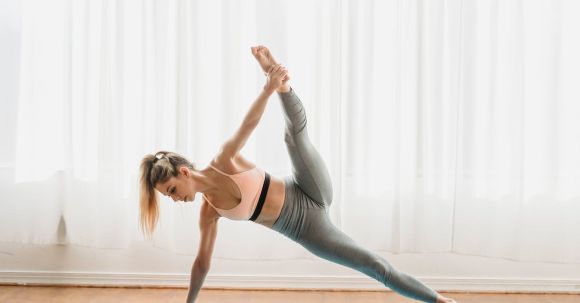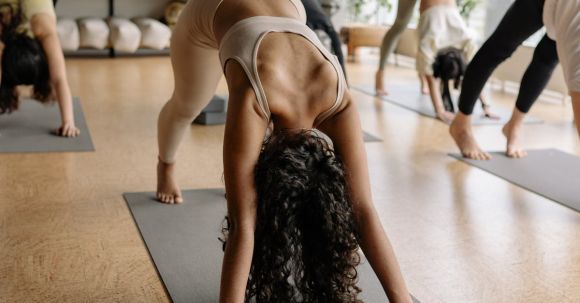Getting a good night's sleep is essential for our overall well-being. It helps us recharge our bodies and minds, allowing us to wake up feeling refreshed and ready to take on the day. However, many people struggle with sleep issues, finding it difficult to fall asleep or stay asleep throughout the night. If you're one of those people, incorporating cardio exercises into your daily routine may be the solution you've been looking for. In this article, we'll explore how cardio exercises can improve your sleep and relaxation, and we'll also provide you with some examples to get you started.
Blog Posts
Lose Weight and Keep it off with Fit on Programs
Losing weight can be a challenging journey, but with the right tools and programs, it is possible to shed those extra pounds and maintain a healthy weight in the long run. Fit on programs are designed to not only help you lose weight but also teach you how to keep it off. With a focus on sustainable lifestyle changes, these programs provide a holistic approach to weight loss that goes beyond just counting calories. In this article, we will explore the key components of Fit on programs and how they can help you achieve your weight loss goals.Understanding the Science of Weight Loss
Before diving into a Fit on program, it is important to understand the science behind weight loss. Essentially, weight loss occurs when you consume fewer calories than you burn. However, this oversimplified equation does not take into account the various factors that influence weight loss, such as metabolism, hormones, and body composition. Fit on programs take a more comprehensive approach by considering these factors and tailoring their strategies to individual needs.Setting Realistic Goals
One of the first steps in any Fit on program is setting realistic goals. While it can be tempting to strive for rapid weight loss, sustainable weight loss is achieved through gradual and steady progress. Fit on programs help you set achievable goals based on your current weight, body composition, and lifestyle. By breaking down your weight loss journey into smaller milestones, you are more likely to stay motivated and committed to the program.Nutrition and Meal Planning
A major component of Fit on programs is nutrition and meal planning. These programs educate participants about the importance of a balanced diet and provide guidance on making healthier food choices. Rather than focusing on restrictive diets, Fit on programs emphasize the inclusion of nutrient-dense foods that nourish your body. Meal planning tools and resources are often provided to help you create a personalized meal plan that aligns with your weight loss goals.Regular Physical Activity
Exercise is another crucial aspect of Fit on programs. Regular physical activity not only helps you burn calories but also improves overall fitness and boosts metabolism. Fit on programs offer a variety of exercise options, from cardio workouts to strength training and yoga. The key is finding activities that you enjoy and making them a regular part of your routine. By incorporating exercise into your daily life, you not only support your weight loss journey but also improve your overall well-being.Behavioral Change and Mindset
Last but not least, Fit on programs recognize the importance of behavioral change and mindset. Losing weight and keeping it off requires a shift in habits and perspectives. Fit on programs provide guidance on overcoming emotional eating, developing healthy coping mechanisms, and adopting a positive mindset. By addressing the underlying factors that contribute to weight gain, these programs empower you to make lasting changes and maintain a healthy lifestyle. In conclusion, Fit on programs offer a comprehensive approach to weight loss that goes beyond just shedding pounds. By focusing on sustainable lifestyle changes, these programs help you lose weight and maintain it in the long run. By understanding the science of weight loss, setting realistic goals, emphasizing nutrition and meal planning, incorporating regular physical activity, and addressing behavioral change and mindset, Fit on programs provide the tools and support needed to achieve lasting results. So, if you are ready to embark on a successful weight loss journey, consider joining a Fit on program today. Your future self will thank you!
In today's fast-paced world, finding time to prioritize our health and fitness can be challenging. However, taking care of our cardiovascular health is crucial to living a long and healthy life. Fortunately, you don't need a gym membership or expensive equipment to improve your cardiovascular fitness. With the right home workouts, you can boost your cardiovascular health and achieve your fitness goals right from the comfort of your own home.
Benefits of Home Workouts
Home workouts offer numerous benefits, particularly when it comes to cardiovascular health. Firstly, they provide convenience and flexibility, allowing you to exercise whenever and wherever you choose. Additionally, home workouts save you time and money by eliminating the need for commuting to and from a gym. Furthermore, home workouts offer privacy and comfort, enabling you to exercise without feeling self-conscious or judged by others.Interval Training: A Powerful Cardiovascular Workout
One highly effective type of home workout for improving cardiovascular health is interval training. Interval training involves alternating between high-intensity exercises and periods of rest or low-intensity activity. This type of workout increases your heart rate, improves your lung capacity, and boosts your overall cardiovascular fitness. To incorporate interval training into your home workouts, you can try exercises such as burpees, jumping jacks, mountain climbers, or high knees. Perform each exercise at a high intensity for 30 seconds, followed by 30 seconds of rest. Repeat this cycle for 10-15 minutes to get an intense cardiovascular workout.Bodyweight Exercises: Strengthen Your Heart and Muscles
Another fantastic way to enhance your cardiovascular health through home workouts is by incorporating bodyweight exercises into your routine. Bodyweight exercises use your own body as resistance, making them convenient and accessible for everyone. Push-ups, squats, lunges, and planks are excellent examples of bodyweight exercises that target multiple muscle groups while simultaneously increasing your heart rate. Aim for three sets of 10-15 repetitions for each exercise to get a comprehensive cardiovascular and strength-building workout.Jump Rope: A Fun and Effective Cardio Exercise
If you're looking for a fun and effective way to improve your cardiovascular health at home, consider adding a jump rope to your workout routine. Jumping rope is a high-impact aerobic exercise that engages your entire body, including your cardiovascular system. It helps to improve your coordination, agility, and cardiovascular endurance. Start with a warm-up by jumping rope at a moderate pace for 5 minutes, then increase your intensity for another 10-15 minutes. Incorporate variations such as single leg jumps or double unders to challenge yourself and maximize the cardiovascular benefits.Stair Climbing: Utilize Your Home's Built-in Equipment
If you have a staircase in your home, you have a valuable piece of equipment to improve your cardiovascular health. Stair climbing is a simple yet effective exercise that elevates your heart rate and works your leg muscles. To incorporate stair climbing into your home workouts, start by briskly walking up and down the stairs for 5-10 minutes. As you get more comfortable, increase your speed and intensity by jogging or running up the stairs. Aim for at least three sets of 10-15 repetitions to get a challenging cardiovascular workout. Incorporate these home workouts into your routine, and you'll be well on your way to improving your cardiovascular health without ever stepping foot in a gym. Remember to start slowly and gradually increase the intensity and duration of your workouts. Consistency is key, so aim for at least 150 minutes of moderate-intensity aerobic exercise or 75 minutes of vigorous-intensity exercise each week. Take care of your cardiovascular health and enjoy the benefits of a stronger heart, increased stamina, and improved overall well-being.
Maintaining a strong core and good posture is important for overall health and well-being. A strong core helps to support the spine and can prevent injuries, while good posture can improve breathing, digestion, and even mental clarity. If you're looking for a way to strengthen your core and improve your posture, look no further than Fit on. This innovative fitness program combines core-strengthening exercises with posture-correcting techniques to help you achieve optimal health and vitality.
The Importance of a Strong Core
A strong core is the foundation of a healthy body. It consists of the muscles in your abdomen, back, and pelvis, and plays a crucial role in maintaining stability and balance. When your core muscles are weak, it can lead to poor posture, back pain, and even injury. By strengthening your core, you can improve your overall strength and stability, making everyday activities easier and more enjoyable.How Fit on Can Help
Fit on is a unique fitness program that focuses on strengthening the core and improving posture. It incorporates a variety of exercises that target the core muscles, such as planks, crunches, and leg lifts. These exercises are designed to engage the deep muscles of the abdomen and back, helping to build strength and stability from the inside out. By consistently practicing these exercises, you can develop a strong core that will support your body and improve your overall posture.Correcting Poor Posture
Poor posture is a common problem that can lead to a variety of health issues, including back pain, muscle imbalances, and reduced lung capacity. Fit on includes posture-correcting techniques that can help you improve your alignment and maintain proper posture throughout the day. These techniques focus on strengthening the muscles that support good posture, such as the upper back, shoulders, and neck. By incorporating these techniques into your daily routine, you can gradually correct your posture and experience the many benefits that come with it.The Benefits of Fit on
Fit on offers a range of benefits for those looking to strengthen their core and improve their posture. Some of the key benefits include: 1. Increased core strength: By consistently practicing the core-strengthening exercises in Fit on, you can build a strong and stable core that will support your body and prevent injuries. 2. Improved posture: Fit on's posture-correcting techniques can help you improve your alignment and maintain proper posture throughout the day, reducing the risk of back pain and other posture-related issues. 3. Enhanced physical performance: A strong core and good posture can improve your balance, stability, and overall physical performance. Whether you're an athlete or just looking to stay active, Fit on can help you perform at your best. 4. Better breathing and digestion: Good posture allows for proper breathing and digestion, leading to improved overall health and vitality. 5. Increased self-confidence: When you have a strong core and good posture, you feel more confident in your body and how you carry yourself. Fit on can help you improve your self-image and boost your self-confidence. In conclusion, Fit on is an effective fitness program that can help you strengthen your core and improve your posture. By incorporating core-strengthening exercises and posture-correcting techniques into your routine, you can experience the many benefits that come with a strong core and good posture. Whether you're looking to prevent injuries, enhance your physical performance, or simply improve your overall well-being, Fit on is a great choice. Start your journey to a stronger core and better posture today with Fit on.
In today's fast-paced world, finding time to plan and prepare meals can be a challenge. However, taking the time to create a meal plan can have numerous benefits for both your physical and mental well-being. By incorporating this simple practice into your routine, you can save time, improve your health, and reduce stress. Let's explore the many advantages of meal planning.
Save Time and Money
One of the most significant benefits of meal planning is the time and money it can save you. By having a plan in place, you can avoid last-minute trips to the grocery store and impulse purchases. With a clear list of ingredients, you will be able to shop more efficiently and stay within your budget. Additionally, by prepping meals in advance, you can eliminate the need for daily cooking and reduce the time spent in the kitchen.Promote Healthy Eating
Meal planning allows you to take control of your nutrition and make healthier choices. When you plan your meals in advance, you have time to consider the nutritional value of each dish and ensure a balanced diet. You can incorporate more fruits, vegetables, whole grains, and lean proteins into your meals, while reducing the intake of processed foods and unhealthy fats. By consistently eating well-balanced meals, you can improve your overall health and well-being.Reduce Food Waste
Another advantage of meal planning is its ability to reduce food waste. When you plan your meals, you can create a shopping list based on the ingredients you need, eliminating unnecessary purchases. By using up all the ingredients you buy, you can minimize the amount of food that goes to waste. Additionally, you can plan meals that use similar ingredients, allowing you to use up leftovers effectively. By reducing food waste, you not only save money but also contribute to a more sustainable environment.Increase Variety and Experimentation
Meal planning can also help you expand your culinary horizons and experiment with new recipes. When you have a plan in place, you can incorporate a variety of dishes into your meals, ensuring you don't get stuck in a food rut. You can try new cuisines, ingredients, and cooking techniques, making mealtimes more exciting and enjoyable. By exploring different flavors and recipes, you can discover new favorites and expand your cooking skills.Reduce Stress and Improve Mental Well-being
Finally, meal planning can significantly reduce stress and improve your mental well-being. By having a plan in place, you eliminate the daily decision-making process of what to cook for each meal. This can alleviate the stress and anxiety associated with last-minute meal preparation and help you feel more in control of your day. Additionally, knowing that you have healthy and nutritious meals ready to go can provide a sense of comfort and satisfaction, leading to improved mental well-being. In conclusion, meal planning offers numerous benefits that can positively impact your life. By saving time and money, promoting healthy eating, reducing food waste, increasing variety, and reducing stress, you can improve your overall well-being. Incorporating this simple practice into your routine can lead to a healthier, more enjoyable lifestyle. So why not give meal planning a try and see the positive changes it can bring to your life?
Choosing a dietary lifestyle can be a challenging decision, especially with the abundance of options available today. Two popular choices that often come up in the conversation are veganism and vegetarianism. Both diets are known for their focus on plant-based foods, but they differ in their approach to animal products. In this article, we will explore the key differences between vegan and vegetarian diets, as well as the factors to consider when deciding which one is right for you.
Understanding Veganism and Vegetarianism
Before delving into the differences, let's define what veganism and vegetarianism entail. Veganism is a dietary lifestyle that excludes all animal products, including meat, poultry, fish, dairy, eggs, and even honey. Vegans primarily rely on plant-based foods such as fruits, vegetables, legumes, grains, nuts, and seeds. In addition to dietary choices, veganism extends beyond food to exclude other animal-derived products like leather, fur, and cosmetics tested on animals. On the other hand, vegetarianism is a dietary lifestyle that eliminates meat and fish but includes animal by-products like dairy, eggs, and honey. There are different types of vegetarians, ranging from lacto-ovo vegetarians (who consume dairy and eggs) to lacto-vegetarians (who consume dairy but not eggs) and ovo-vegetarians (who consume eggs but not dairy). Some vegetarians may also choose to avoid certain animal by-products, like gelatin or rennet.Nutritional Considerations
When deciding between veganism and vegetarianism, it's important to consider the nutritional aspects of each diet. Vegan diets tend to be rich in fiber, vitamins, minerals, and antioxidants due to the emphasis on whole plant-based foods. However, vegans need to be mindful of potential nutrient deficiencies, especially in vitamin B12, iron, calcium, and omega-3 fatty acids. These nutrients can be obtained through fortified foods or supplements. On the other hand, vegetarian diets that include dairy and eggs can provide adequate amounts of most essential nutrients. Dairy products are a good source of calcium and vitamin D, while eggs are rich in protein and essential vitamins. However, vegetarians should still pay attention to their intake of iron, vitamin B12, and omega-3 fatty acids, as these nutrients are more commonly found in animal-based foods.Ethical and Environmental Considerations
For many individuals, the decision to adopt a vegan or vegetarian lifestyle goes beyond personal health and extends to ethical and environmental concerns. Veganism is often motivated by a desire to reduce animal suffering and exploitation. By eliminating all animal products, vegans aim to promote a more compassionate world for animals. Additionally, vegan diets have a lower carbon footprint since animal agriculture is a significant contributor to greenhouse gas emissions. Vegetarianism, while still promoting a reduction in animal consumption, may be driven by different ethical considerations. Some vegetarians choose this lifestyle for health reasons, religious beliefs, or a desire to support more sustainable agricultural practices. By excluding meat but still consuming animal by-products, vegetarians can make a positive impact while maintaining a more flexible approach.Finding Your Ideal Dietary Lifestyle
Deciding between veganism and vegetarianism ultimately depends on your personal values, health needs, and lifestyle preferences. Consider the following factors when making your decision: 1. Ethics: Reflect on your beliefs regarding animal rights and the exploitation of animals. If you feel strongly about eliminating all animal products, veganism may align better with your values. 2. Nutritional Needs: Assess your current nutrient intake and any potential deficiencies. If you are concerned about meeting certain nutrient requirements without consuming animal by-products, a vegetarian diet that includes dairy and/or eggs may be more suitable. 3. Sustainability: Take into account the environmental impact of your dietary choices. If reducing your carbon footprint and minimizing the exploitation of natural resources are important to you, veganism may be the way to go. Ultimately, the choice between veganism and vegetarianism is a personal one. It's essential to listen to your body, consult with a healthcare professional or registered dietitian, and make a decision that aligns with your values and supports your overall well-being. In conclusion, both veganism and vegetarianism offer viable dietary options for those looking to adopt a plant-based lifestyle. By understanding the differences between these two diets and considering your personal values and health needs, you can make an informed decision about which one is right for you. Whether you choose to go vegan or vegetarian, both choices contribute to a more sustainable and compassionate world.
In order to excel in any sport, it is crucial to develop strength and stamina that are specific to the demands of that particular activity. Sports-specific exercises are designed to target the muscles and energy systems that are most utilized in a given sport, thus improving performance and reducing the risk of injury. Whether you are a professional athlete or a recreational enthusiast, incorporating these exercises into your training routine can take your performance to the next level.
Improve Power and Speed with Plyometrics
Plyometric exercises are explosive movements that help improve power and speed. They involve rapid stretching and contracting of muscles, which enhances the body's ability to generate force quickly. For sports such as basketball, soccer, or tennis, plyometric exercises like box jumps, lateral bounds, and medicine ball throws can be highly beneficial. These exercises not only build strength in the lower body but also improve coordination and agility.Enhance Core Stability for Balance and Control
A strong and stable core is essential for maintaining balance and control in sports that require quick changes in direction or body positioning. Exercises that target the core muscles, such as planks, Russian twists, and standing cable rotations, can help improve stability and prevent injuries. By strengthening the core, athletes can generate more power from their hips and transfer it to their limbs, resulting in better performance on the field or court.Build Endurance with Interval Training
Endurance is crucial for sports that involve continuous activity over an extended period of time, such as long-distance running, cycling, or swimming. Interval training is an effective method to improve endurance by alternating between high-intensity and low-intensity exercises. This type of training challenges the cardiovascular system and increases the body's ability to sustain effort for longer durations. Incorporating interval training sessions into your routine can help build stamina and improve overall athletic performance.Target Sport-specific Muscles with Resistance Training
Resistance training is a key component of sports-specific exercises as it helps target and strengthen the muscles that are most used in a particular sport. For example, a soccer player can benefit from exercises that focus on the lower body, such as squats, lunges, and hamstring curls. On the other hand, a swimmer may focus on upper body exercises like pull-ups, shoulder presses, and tricep dips. By tailoring resistance training to the specific demands of your sport, you can optimize muscle development and improve performance.Incorporate Agility Drills for Quickness and Responsiveness
Agility is the ability to change direction quickly and efficiently, which is crucial in sports like basketball, soccer, and tennis. Agility drills, such as ladder drills, cone drills, and shuttle runs, can improve footwork, reaction time, and overall quickness. These exercises challenge the neuromuscular system, improving coordination and proprioception. By incorporating agility drills into your training routine, you can enhance your ability to react swiftly and effectively on the field or court.Conclusion: Take Your Performance to the Next Level
Sports-specific exercises are essential for building strength and stamina that are tailored to the demands of your chosen sport. By incorporating plyometrics, core stability exercises, interval training, resistance training, and agility drills into your training routine, you can optimize your athletic performance and reduce the risk of injury. Remember to consult with a qualified trainer or coach to ensure that you are performing these exercises correctly and safely. With dedication and consistency, you can take your performance to the next level and achieve your goals in your chosen sport.
Yoga is a fantastic way to improve flexibility, strength, and mental clarity. For beginners, however, it can be intimidating to jump into a yoga challenge without knowing what to expect. If you're ready to take on a beginner's yoga challenge and want to make sure you nail the fit, here are some tips to help you get started.
Start with the Basics
Before diving into a yoga challenge, it's essential to familiarize yourself with the basics of yoga. Understanding the fundamental poses, breathing techniques, and proper form will set you up for success. Take the time to attend a few beginner yoga classes or watch online tutorials to learn the foundations.Set Realistic Goals
When embarking on a yoga challenge, it's important to set realistic goals. Don't expect to become a master yogi overnight. Instead, focus on small, achievable milestones. Whether your goal is to hold a pose for a certain amount of time or to complete a specific sequence, breaking it down into manageable steps will keep you motivated and prevent burnout.Listen to Your Body
Yoga is a practice that is meant to be gentle and nurturing. It's crucial to listen to your body and honor its limits. Pushing yourself too hard too soon can lead to injury or frustration. Pay attention to how your body feels during each pose and adjust accordingly. Remember, it's not about how deep you can go into a pose but how it feels in your body.Practice Consistency
Consistency is key when it comes to nailing the fit on a yoga challenge. Set aside dedicated time each day to practice, even if it's just for a few minutes. Consistency will help you build strength, flexibility, and improve your overall performance. Find a time that works best for you, whether it's in the morning, during lunch break, or in the evening, and stick to it.Focus on Breath
One of the essential aspects of yoga is the breath. Paying attention to your breath during each pose will help you stay present and centered. Practice deep, mindful breathing throughout your practice, inhaling deeply through your nose, and exhaling fully through your mouth. Connecting with your breath will not only enhance your yoga experience but also promote relaxation and stress relief.Modify as Needed
Yoga is a highly customizable practice, and it's essential to modify poses as needed. Don't be afraid to use props such as blocks, straps, or blankets to support your body. Modifying poses allows you to adapt them to your current level of flexibility and strength. Embrace modifications and make the practice work for you.Stay Positive
Yoga challenges can be physically and mentally demanding, but it's crucial to stay positive throughout the journey. Celebrate your progress, no matter how small, and don't compare yourself to others. Each person's yoga journey is unique, and progress looks different for everyone. Embrace the process and be kind to yourself along the way. In conclusion, Embarking on a beginner's yoga challenge can be an exciting and transformative experience. By starting with the basics, setting realistic goals, listening to your body, practicing consistency, focusing on breath, modifying as needed, and staying positive, you can nail the fit and make the most out of your yoga journey. Remember, it's not about perfection but about progress and self-discovery. Enjoy the process and embrace the many benefits that yoga has to offer.
Leading a sedentary lifestyle has become a common problem in today's fast-paced world. With long hours spent sitting at desks and constantly being surrounded by technology, it's no wonder that many people struggle to find time for exercise. However, incorporating physical activity into your daily routine is essential for maintaining good health. If you're looking for a fun and motivating way to get moving, the Fit on Step Tracker Challenge might be just what you need.
What is the Fit on Step Tracker Challenge?
The Fit on Step Tracker Challenge is a virtual fitness challenge that encourages participants to increase their daily step count. By using a step tracking device or smartphone app, participants can easily monitor their progress and compete against others in the challenge. The goal is to take more steps each day and ultimately lead a more active lifestyle.Why should you join the challenge?
1. Stay motivated
Joining the Fit on Step Tracker Challenge provides a great source of motivation. Knowing that you're part of a community of individuals striving for the same goal can be incredibly inspiring. Plus, the friendly competition aspect adds an extra layer of excitement. It's a fun way to stay motivated and keep pushing yourself to achieve your step count goals.2. Improve your health
Increasing your daily step count has numerous health benefits. Walking is a low-impact exercise that can help improve cardiovascular health, strengthen muscles, and boost overall fitness. It can also aid in weight management and reduce the risk of chronic conditions such as heart disease and diabetes. By participating in the Fit on Step Tracker Challenge, you'll be taking a significant step towards improving your health and well-being.3. Discover new opportunities
Joining the challenge can open doors to new opportunities for physical activity. As you strive to increase your step count, you may find yourself exploring new walking routes or trying out different activities. It's a chance to break free from your usual routine and discover the joy of being active in various settings. Whether it's walking in nature, exploring your city, or even taking the stairs instead of the elevator, every step counts towards your overall progress.How to join the Fit on Step Tracker Challenge
1. Choose a step tracking device or app
To participate in the challenge, you'll need a step tracking device or app. There are numerous options available, ranging from wearable fitness trackers to smartphone apps. Choose one that suits your preferences and budget. Make sure it accurately measures your steps and syncs with the challenge platform.2. Sign up for the challenge
Once you have your step tracking device or app, it's time to sign up for the challenge. Visit the Fit on Step Tracker Challenge website or app and follow the registration instructions. You may need to create an account and provide some basic information. Once you're registered, you'll gain access to the challenge platform and be ready to start tracking your steps.3. Set your step count goals
Before you begin the challenge, it's essential to set realistic step count goals. Start by tracking your average daily steps for a week to get a baseline. Then, gradually increase your step count each week. Aim to add an additional 500-1,000 steps per day until you reach your desired goal. Remember, the purpose is to make small, sustainable changes that lead to a more active lifestyle.In conclusion
Joining the Fit on Step Tracker Challenge is an excellent way to incorporate more physical activity into your daily life. By tracking your steps and competing against others, you'll stay motivated, improve your health, and discover new opportunities for exercise. So why wait? Lace up your sneakers, grab your step tracking device, and start stepping towards a more active and fulfilling lifestyle today.
In today's fast-paced world, finding time to hit the gym can be a challenge. Between work, family, and other obligations, it's easy to put exercise on the back burner. However, with the rise of online personal training, staying fit and healthy has never been more convenient. In this article, we will explore how online personal training can help you train smarter, not harder, and achieve your fitness goals.








